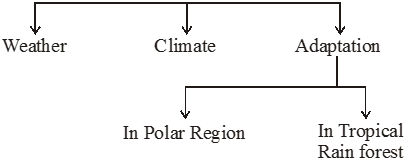- Books Name
- CBSE Class 7 Science Book
- Publication
- Param Publication
- Course
- CBSE Class 7
- Subject
- Science
Adaptation
Adaptation are special characteristics developed by organisms to live comfortably and successfully under a prevailing set of environmental conditions. Adaptations may be morphological, physiological or behavioural or a combination of them. Adaptation develop through the process of natural selection. The ultimate aim of all adaptations is to make the individual fit to obtain food & space for its survival, opportunities for its reproduction & rearing of young ones.

Adaptation of animals to climate
Climate of an area greatly affect the flora, fauna and soil of the region. Animals are well adapted to their surrounding conditions, so that they can easily survive. Animals special features and habits helps them to adapt themselves to surroundings that result in evolution.
Climate and adaptation
Climatic adaptation refers to adaptations of an organism that are triggered due to the patterns of variation of abiotic factors that determine a specific climate. Annual means, seasonal variation and daily patterns of abiotic factors are properties of a climate where organisms can be adapted to. Changes in behavior, physical structure, internal mechanisms and metabolism are forms of adaptation that is caused by climate properties. Organisms of the same species that occur in different climates can be compared to determine which adaptations are due to climate and which are influenced majorly by other factors. Climatic adaptations limits to adaptations that have been established, characterizing species that live within the specific climate. It is different from Climate change adaptations which refers to the ability to adapt to gradual changes of a climate. Once a climate has changed, the climate change adaptation that led to the survival of the specific organisms as a species can be seen as a climatic adaptation.

 Param Publication
Param Publication
 Grow Career Publication
Grow Career Publication
